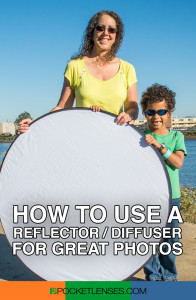 The most important factor in a photo is the light. No light, no photo. Being able to control the quality, intensity and direction of light can mean the difference between a “meh” snapshot and a great image.
The most important factor in a photo is the light. No light, no photo. Being able to control the quality, intensity and direction of light can mean the difference between a “meh” snapshot and a great image.
In this article I’m going to share with you a great little secret handheld gadget that will help you control light and get those great photos.
A photo reflector / diffuser is a great light-controlling tool. They’re pretty much universal, will work with all camera brands and will even work with smartphone and point and shoot cameras! They’re not very expensive, there are no electronics and they’re extremely effective IF you know what you’re doing. Read on and learn the art of reflecting and diffusing like a pro!
A circular “pop up” reflector can come in many sizes. Some are called 5 in 1 reflectors because they typically have four surfaces (white, silver, gold and black) and a translucent panel: hence 5 in 1. For this article (and video) I’m going to focus on 2 of these aspects, the white reflector and the translucent diffuser. By learning how to use these two panels, you could probably figure out how to use the other 3.
Using the white panel you can utilize the reflector mode of the gadget to reflect light onto your subject. Take a look at the examples and see the obvious difference it can make. Experiment with angle and distance. Try to vary the “key” light (usually the sun), your subject and the angle of the reflector. I often like to shoot with the sun slightly behind the person so that it backlights them a bit and then use the reflector to fill in, what would have been shadows, on the model.
By removing the “outer shell” you’ll find the diffuser panel. This is a translucent panel that will let light through, but still provide some shade. Holding it above your subject, you can block out the harsh rays of the sun while at the same time providing a nice soft bit of illumination. Your subject is less likely to squint because of the harsh sunlight and the shadows on their face will be softened by the diffuser. Bonus! If you do it just right you can still get some nice catch light sparkles in their eyes from either the reflective or diffusive use of the gadget.
Pro tip: as counter intuitive as it may sound, the closer you bring the gadget to your subject, the softer the light will be. I don’t mean dimmer, I mean SOFTER as in less edge cutting shadows harsh.
Now for some bonus material!
Go to this link for a Flickr set to see some images that might help with understanding.
Check out the video below for the audio / visual demo of this technique.
If you’d like to purchase the models I own, here they are: The small 12″ reflector and the larger 43″ 5 in 1 Reflector.
Leave a comment below if you have any questions or comments on the use of the reflector / diffuser. Thanks!
Photography and travel!







This is great information. I’ve seen these used on video shoots, but your explanations and examples really helped me to understand their use. Thanks.
Phil, you’re welcome. I think they’re one of the easier lighting sources to understand. You don’t have to know about guide number, diffusers, high speed sync or watt per second ratings. Just reflect or diffuse, keep them close to your subject and see the difference they make.
Once again, a very helpful video. Never even knew that someone like me (not a pro) could use this type of equipment let alone how to use it. Nice job. Thanks.
Sheryl, you’re most welcome! They’re pretty easy to use. Here’s one that’s an in between size – 24″. These can be used with smartphones and point and shoot cameras for some great results as well. http://www.amazon.com/exec/obidos/ASIN/B005M09B4E/pocklens-20
Outside of a “harder” to store size, any other downsides to just having the larger reflector set? I’d rather buy one than two sets at this point. Thanks Sonny!
Jon, No real downsides. The quality of light is actually much better and softer from a larger surface. I suppose if I were to be really nit picky, the larger size is harder to control on a windy day, especially if you’re a 6 year old kid …
Just be sure to know that once you buy one of these you need to learn how to fold it back up as it’s not always easy or intuitive. Check out some videos on YouTube for help. Great job Sonny
SO true! That’s a good point. I may just have to make a video showing this!
Sonny, this was a great video tutorial. That 5 in 1 is the exact one I have now. Good to get some tips. Haven’t used it yet but now I’m inspired to get busy and try it! Thanks!
Hey Lori! Take a bit of practice, but worth it!
Nice explanations and examples, Sonny. Before I left the store with mine, I asked the salesperson to show me how to fold it up to fit back into its case.
🙂 A really important thing to learn. Takes practice!
Excellent, Sonny. Since I don’t have an appropriate hot shoe for off camera flash on my Panasonic cameras, your diffuser video is extremely good information.
Hey Marilyn, Yup, that’s another great reason to learn how to use a reflector!
Perfecte uitleg zeer goed en leerrijk, hartelijk dank.
Graag gedaan
This was SO helpful. Thank you, Sonny!
Would this also apply to indoor use? I’m about to try using an LED lamp (with temperature and intensity controls) to help improve lightening for online interviews and webinars. My office is actually a retired greenhouse, so it gets PLENTY of light- but my desk is turned away from most of the windows (aside from one narrow window to my front-left side) and there’s often a lot of shadowing that occurs on my face.
I was thinking of having a diffusing panel clamped in front of the LED, in hopes of creating a softer, more natural light. And maybe add a reflecting surface on the other side of me?
I have virtually NO experience with this, so I’m flying by the seat of my pants. Does this sound like it could work?
Thanks again!
Sharon